This is a no-knead French sourdough baguette recipe that uses 100% natural wild yeast in the form of a rye sourdough starter. The crust is super crunchy yet delicate and the crumb airy and slightly chewy. All the perfect qualities you'll find in the best baguette you'll ever make.
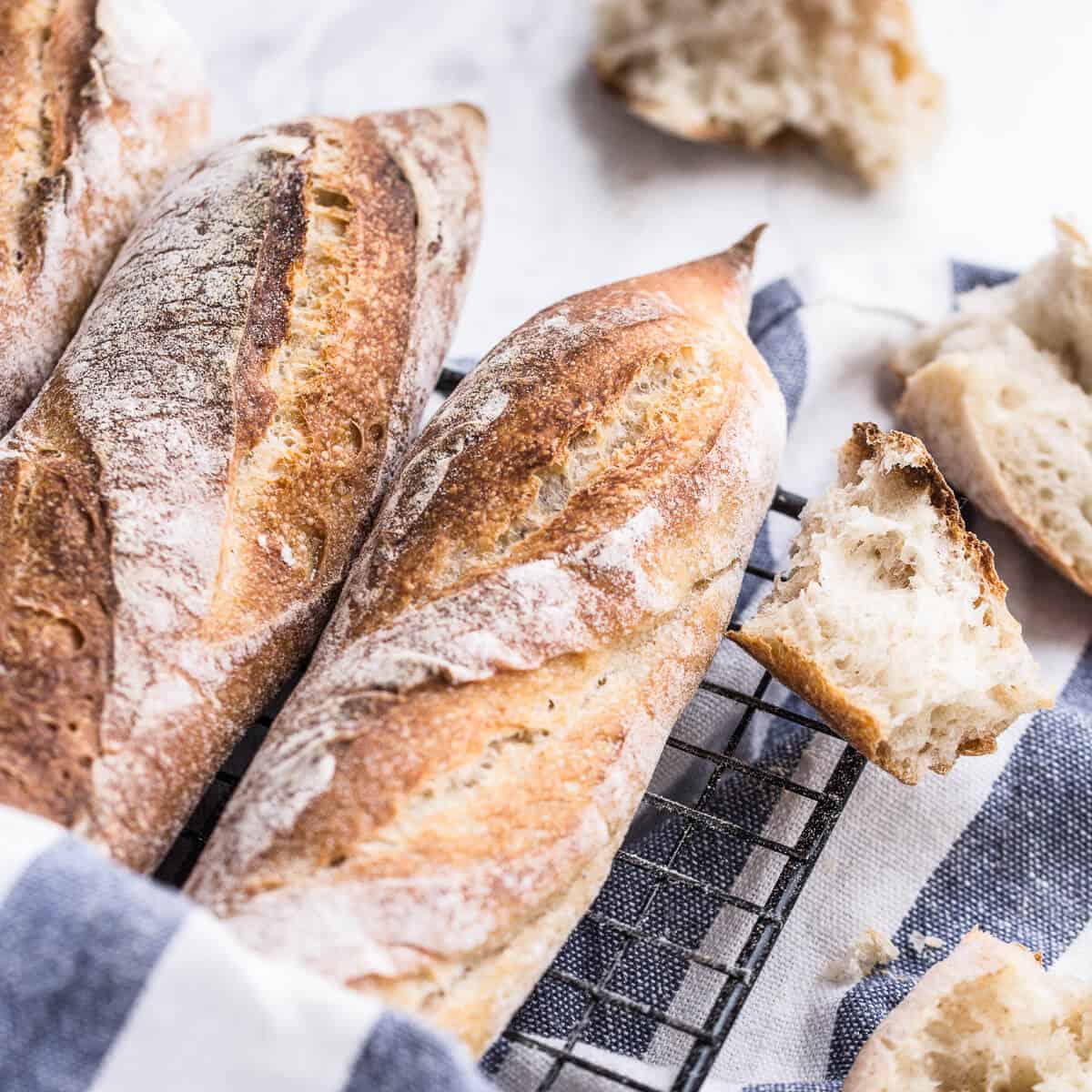
Jump to:
- What is a baguette
- Are all baguettes sourdough
- The secret to getting the perfect crust
- Useful equipment for this recipe
- Schedule
- Ingredients needed
- How to make the dough
- How to shape a baguette
- How to bake it
- How to soften hard baguette
- Variations
- Serving suggestions
- Frequently asked questions
- Other recipes you might like
- Recipe
- Comments
What is a baguette
The word baguette simply means "batton" or "stick". Pretty obviously because of its shape.
Baguette, pronounced ba-get, is a long round shaped loaf of bread that originated in France in the early 19th century around the time when steam ovens were introduced.
The history of baguette is extremely colourful and mostly just fairy tales.
What we deem a classic/trendy bread now was just a basic means to an end back then. Feeding a hungry tummy.
For this reason, many legends have been creatively invented and they all make for good reading.
Simply put.
The baguette is a comfortable-to-carry, comfortable-to-cut multifunctional loaf of bread that's loved by millions of people around the world.
Are all baguettes sourdough
Traditionally baguettes aren't made with sourdough but rather with fresh yeast.
The process takes a lot quicker but the result is much inferior to a sourdough baguette.
This is an overnight sourdough baguette recipe and it ensures that the fermentation process takes a longer time, which in turn gives us much tastier bread and also the best texture a sourdough loaf could have.
Crunchy, soft and chewy.
The secret to getting the perfect crust
In short. You need moisture. Sounds strange? Maybe so but, that's what makes bread have a crunchy crust.
When we make bread we hydrate starches. The starch at room temperature only takes up about 40% of its potential hydration level.
When we cook the bread those hydrated starches take up more moisture the closer it gets to 82 degrees Celsius or 180 degrees Fahrenheit. At this temperature, starches gelatinise irreversibly.
The high moisture level ensures that the temperature of the dough rises very slowly.
The yeast can perform a final super charged fermentation and the bubbles already trapped in the dough has time to expand before the protein structure around them sets.
To make a crispy crust we want to bombard the hydrated starches with moisture so that they become so saturated with moisture, they burst and form a liquid gel.
This gel, in turn, bakes into a glass-like structure or thin crust and then finally browns due to the Maillard reaction.
Conclusion.
The first 10 minutes of baking is crucial as the moisture level during this period needs to be kept at a maximum. We don't want the exterior to dry out and set while the inside is still expanding.
Make sure your oven is extra steamy by placing a container with boiling water in it.
Spray the inside of the oven and also the loaf with a fine water mist every 2 minutes during the first 10 minutes of baking.
More on all that technical stuff here if you are interested in the science.
Useful equipment for this recipe
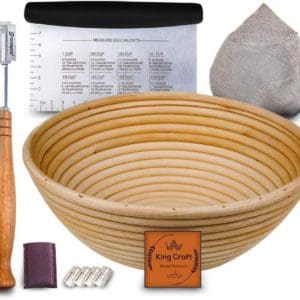
Bread Baking Set

Electronic Kitchen Scales
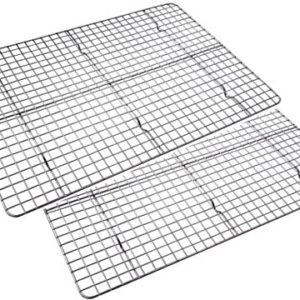
Cooling Racks
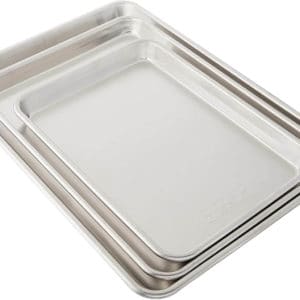
Baking Sheets
Schedule
Day 1:
- 09:00 am - Feed your starter first thing in the morning.
- 18:00 pm - Make the dough and autolyse
- 19:15 pm - Add the salt and give it the first stretch and fold. Let it rest for 45 minutes.
- 20:15 pm - Stretch and fold. Cover and rest for 45 minutes.
- 21:30 pm - Stretch and fold. Cover and rest for 45 minutes.
- 22:15 pm - Shape the dough and let it ferment in the fridge overnight.
Day 2:
- 08:00 am - Remove the baguettes from the fridge and let it sit at room temperature for an hour.
- 08:30 am - Turn oven to 250 degrees Celsius or 480 degrees Fahrenheit. Place a pan filled with water in the bottom of the oven along with a baking tray or baking stone.
- 09:00 am - Dust semolina onto hot tray or baking stone. Place baguettes onto it. Slash with a lame or sharp knife.
- 09:15 am - Bake for 30 minutes. After 15 minutes, rotate the tray and turn the oven down to 220 degrees Celsius or 428 degrees Fahrenheit. Remove the baguettes from the oven and let them cool down on a wire rack before slicing or simply breaking off pieces and enjoy with some good butter or olive oil.
Ingredients needed

- Starter - Use my rye starter recipe or, if you already have a sourdough starter then use what you have.
- Flour - Use all-purpose flour that has a protein content of between 10 - 12 per cent. You can use stronger flour but, don't go any lower. I've also included some other substitutes you can use a bit further down in the post.
How to make the dough
For detailed timings see the schedule above or recipe card. Here is the step by step guide for the best sourdough baguette recipe.

- Feed your starter with 50 grams white bread flour and 50 grams clean drinkable water. Let it sit at room temperature covered for 9 hours.
- Mix 250 grams of water with 100 grams sourdough starter. Add in the flour and mix until fully incorporated. Cover and rest for 1 hour. During this time dissolve the salt in the remaining 30 grams water.
- Add the salty water to the dough and mix through well until the dough is smooth. Give it a stretch and fold by pulling up one side of the dough and folding it over itself, repeating around the perimeter of the dough. When done, form into a ball and place into a clean, lightly oiled bowl and cover with a damp cloth or plastic wrap. Let it rest for 45 minutes.
- Repeat the stretch and fold. Cover and let the dough rest for another 45 minutes.
- Stretch and fold a final time and rest covered again for 45 minutes. During this time prepare an oven tray lined with a well-floured couche or linen towel.
- Place the dough onto a floured work surface and divide into 4 roughly equal pieces ready for the important shaping step.
How to shape a baguette

- Flour your hands and stretch each piece into a rough rectangle.
- For each piece do the following. Fold over the top part towards yourself with you thumbs pushing into the dough and away from you. This creates tension in the dough.
- Repeat this until the dough is rolled up.
- Seal the seam with the floured palm of your hand and then pinch close if needed with your thumb and forefinger.
- Roll the shaped dough into a long sausage. Start with both hands in the middle of the dough and work your way towards the ends where you apply more pressure to give it the signature pointy ears.
- Place seam-side up onto the lined and floured tray. Dust with more flour mix. Cover with plastic wrap and place into the fridge overnight.
How to bake it

- Turn your oven to 250 degrees Celsius or 480 degrees Fahrenheit. Place a container filled with water in the bottom of the oven. Place your baking tray or pizza stone into the oven so it's hot when you need to bake.
- Dust the hot tray with semolina flour. Place the baguettes seam side down onto the baking sheet. Use a lame or sharp knife to slash the loaves. The cuts should be made at a 25-degree angle and 1,5 centimetres deep.
- Place the baguettes into the oven and bake for 30 minutes. After 15 minutes, rotate the baking sheet and turn the oven down to 220 degrees Celsius or 428 degrees Fahrenheit. Remove the baguettes from the oven. Let them cool down slightly and admire their crunchy crust and pillowy crumb before slicing or taring of a piece to sample. Enjoy with some good butter or olive oil.

How to soften hard baguette
When you go through the trouble of making your own sourdough baguette all the way from scratch, you obviously want to use it all instead of giving it to the pigeons.
Refreshing it is easy and you don't waste a crumb.
Hard baguette means it has dried out and the little moisture that was in there has evaporated.
This is easily fixed.
Remember we talked about hydrated starches irreversibly gelatinise when the bread is baked? This means that the structure of the bread is fully intact and the only thing we need to do is replace the lost moisture.
To do this you need to run or dip your bread into water. Make sure the crust is completely wet. This all may sound crazy but it works. So, let's continue.
Turn your oven to 160 degrees Celsius or 320 degrees Fahrenheit.
Place the soaked baguettes on a lined oven tray or baking sheet and bake for 10 minutes.
After the time is up, your stale baguette will be good as new with a crunchy crust and soft interior.
Note that you can not repeat this process over and over. Once you used this lifeline, that is it.
Variations
You don't have to stick to the classical white baguette. You can easily modify this recipe by doing the following.
- Mix the flour - Replace 10 per cent of the white flour with rye, wholewheat, spelt, buckwheat, oat or flax meal to name a few.
- Seeds and dried fruit - Add in chopped dried apricots, cranberry, cherries, walnuts, or pumpkin seeds.
- Add vegetables - When shaping the dough fold in some garlic, caramelised onion or even baked pumpkin to the centre of the loaves.
- Use another liquid - Use beer or pumpkin stock instead of plain water.
- Other add-ins - For a burst of colour add a tablespoon of one of the following. Turmeric powder, cocoa powder, blue pea flower powder.
Serving suggestions
Like with any good sourdough bread you can simply have it with good butter or go the extra step and cook something else delicious to serve it with.
- Sandwiches - Make a simple cheese and ham sandwich for a truly French snack. refrain from overloading it with soft ingredients. Because the crust is crispy and interior chewy, it's best to use dry ingredients like cheese, ham, liver spread or something down those lines.
- With soup - Toast it or simply dip into your favourite soup like Ukrainian borscht or creamy potato and leek soup.
- Croutons - Make croutons for salads by drizzling with olive oil, salt and pepper and baking until crispy in the oven.
- With dips - Dip into baked Morrocan eggplant or pea and mint dip. My favourite is to dip into good olive oil, homemade balsamic glaze and Egyptian dukkah.
Frequently asked questions
Once completely cooled you should store it airtight and keep it in a cool dry place. It will keep for up to 5 days. Do not store in the fridge as bread goes stale quicker in the fridge.
You can easily bake and freeze sourdough baguettes for longer storage and for the convenience of having freshly baked bread to hand at all times.
I suggest you slice the bread and store in airtight ziplock bags. It will keep for up to 3 months.
Because baguette is a long round shape you will have trouble just popping it into a regular toaster. It is also browned all over so if you cut it in half lengthways you might burn the already browned side. The best way is to either fry it in a pan or toast it under the grill drizzled with a bit of olive oil.
Other recipes you might like
If you love baking bread are desserts then you will find the following recipes useful.
This site contains affiliate links. I may earn a tiny commission on qualifying purchases at no extra cost to you. By bookmarking these links you help support the upkeep of this site.
If you found this post helpful or have learned something, comment, subscribe, and follow me on social platforms for more tasty recipes.
Recipe
Sourdough Baguettes
Ingredients
For the baguette dough
- 450 g (3.6 cups) flour - white bread
- 280 g (1.1 cups) water
- 100 g (0.4 cups) active sourdough starter
- 15 g (3.0 teaspoon) salt
Instructions
Day 1 - Making the dough (This all happens at room temperature)
- 09:00 am - Feed your starter with 50g white bread flour and 50g clean drinkable water. Let it sit at room temperature covered.
- 18:00 pm - Mix 250g of water with 100g ripe and ready sourdough starter. Add in the flour and mix until fully incorporated. Cover and rest for 1 hour. During this time dissolve the salt in the remaining 30g water.
- 19:15 pm - Add the salty water to the dough and mix through well until the dough is smooth. Give it a stretch and fold by pulling up one side of the dough and folding it over itself, repeating around the perimeter of the dough. When done, form into a ball and place into a clean, lightly oiled bowl and cover with a damp cloth or plastic wrap. Let it rest for 45 minutes.
- 20:15 pm - Repeat the stretch and fold. Cover and let the dough rest for another 45 minutes.
- 21:30 pm - Repeat the previous step and rest covered again for 45 minutes. During this time prepare an oven tray lined with a well-floured couche or linen towel. You will use the flour/semolina mix.
- 22:15 pm - Shape the dough. Place the dough onto a floured work surface and divide into 4 pieces. Flour your hands and stretch each piece into a rough rectangle. For each piece do the following. Fold over the top part towards yourself with you thumbs pushing into the dough and away from you. This creates tension in the dough. Repeat this until the dough is rolled up. Seal the seam with the floured palm of your hand and then pinch close if needed with your thumb and forefinger. Roll the shaped dough into a long sausage. Start with both hands in the middle of the dough and work your way towards the ends where you apply more pressure to give it the signature pointy ears. Place seam-side up onto the lined and floured tray. Dust with more flour mix. Cover with plastic wrap and place into the fridge for slow overnight fermentation.
Day 2 - Baking the baguettes
- 08:00 am - Remove the baguettes from the fridge and let it sit at room temperature for about an hour.
- 08:30 am - Turn your oven to 250 degrees Celsius or 480 degrees Fahrenheit and place a pan filled with water in the bottom of the oven. Steamy oven means great bread will follow. Place a baking sheet in the oven too so that it's nice and hot when you need it.
- 09:00 am - Dust some semolina flour mix onto the hot tray from the oven. Place the baguettes seam side down onto the hot tray. Use a lame or a very sharp knife to slash the baguettes diagonally lengthways down the bread. The cuts should be made at a 25-degree angle and 1,5 centimetres deep.
- 09:15 am - Time to bake. Place the slashed loaves into the oven and bake for 30 minutes. After 15 minutes, rotate the tray and turn the oven down to 220 degrees Celsius or 428 degrees Fahrenheit. Remove the baguettes from the oven and let them cool down on a wire rack before slicing or simply breaking of pieces and enjoy with some good butter or olive oil.
Video
Notes
- Sourdough baguettes will last for about 5 days sealed airtight. They will lose their crunch but you can refresh them by toasting or frying in a pan with a bit of olive oil.
- It can be frozen for up to 3 months. Cut it into slices and store airtight in the freezer for convenience. Whenever you want a little snack or a piece of baguette, simply take a slice from the freezer and warm it up.









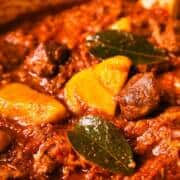








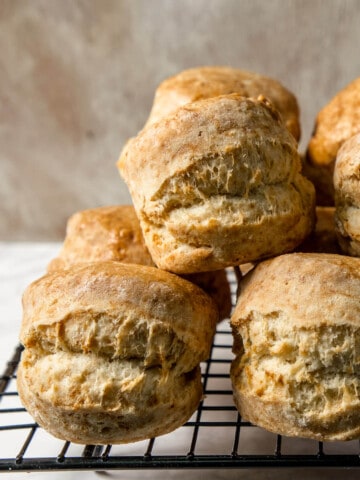
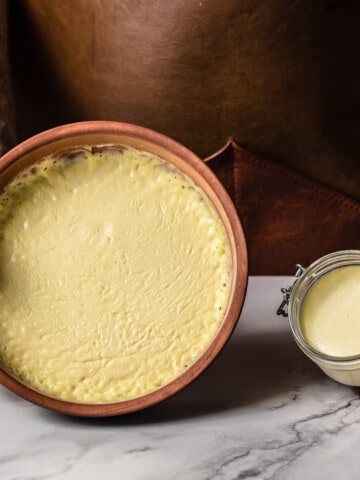


Mark
Just WOW! Amazing sourdough baguettes and I'm a novice home baker. They were crunchy on the outside, light and chewy on the inside. Never knew I would be able to make bread this good at home. Thanks for the detailed instructions especially with the dreaded shaping, which is a struggle and a half.
Alison
Made these over the weekend. They baked up wonderfully.
I've tried a few great sourdough baguette recipes over the years and this recipe is probably my favourite in terms of simplicity and the wonderful instructions.
Thanks so much for sharing and taking the time to explain it all in such detail.
Will also be trying your Borodinsky bread soon. It's caused quite a stir in the "bread baking circles".
My local baker told me your recipe is something truly unique and amazing so got to try it!
xxxxxx
Suzana Wilder
Followed the steps exactly and got perfect baguettes! Thanks for the detailed recipe.
Joe, S
First time baguette maker here! They are amazing. You really know how to explain recipes in such detail.
Jeff B
Hi!
Instead of shaping the baguettes before the long refrigerator rise, can I just put the dough in the fridge overnight, then next day divide the dough, shape baguettes and let proof for an hour before baking? I don’t have room in my fridge for a pan of baguettes.
Thanks!
Charlé Visser
Jeff, just shape them. And let them proof for a few hours then bake. Same day and no fridge space issues.
Natalia
Hello. I’m planning to make this recipe today. But wanted to clarify the starter. You mention to use your rye starter recipe (which is a mix of white and rye flour, plus water) but in this recipe you say to feed your starter with just white flour and water. Does it matter which one you do? My current starter is a rye one like you mention, it’s doing great so I don’t want to mess with the routine on it. Any suggestions? Thank you
Charlé Visser
Just feed it like you feed it. I only add rye flour to me starter again after a few discards. Rye is like a multivitamin to the yeast.
Anonymous
Perfect baguettes! They are so crunchy! OMG
Narelle
Charle - thank you so much for your generous sharing of your recipes. i made these baguettes and they are magnificent. Great, clear instructions made the process so simple! New best favourite sourdough recipe!
Charlé Visser
Hopefully good))
JR
I'm lazy, so I tend to shy away from overnight recipes, but my wife and teenaged son massively prefer these baguettes to any other recipe. They're so good. Blisters on the crust, and a chewy wonderfullness. Thanks so much.
Is there any reason not to slash them immediately when I take them out of the fridge? When they soften, instead of getting a nice deep slash I get like ... 3 millimeters. (And I bought a--the cheapest, granted--lame, too!)
Charlé Visser
Glad to hear they are popular with the family)
If you get good proof on them in the fridge you can slash cold and bake straight away.
If you slash them under proved it won't turn out well. You could also try popping them back into the fridge for a few minutes once proven to make the slashing a bit easier.
JR
Thanks! Will do.
stephen mackin
So, I tried this recipe. Followed all of the timings and everything seemed good until it came to shaping the baguettes. The dough seemed very wet and I struggled to shape the baguettes - dough sticking to my bench. But I persevered. After refrigerating overnight, the baguettes rose and looked good, at the half way point of baking. Then when I turned them in the oven they seemed to shrink.
Taste really good, just think I must be doing something wrong with the dough.
Will try again.
Charlé Visser
If the dough is hard to handle, reduce the hydration by 3%. Sounds like might have turned them a touch early. Let them develop a good dark crust and then flip. If need be turn the oven temperature up to get a better bake.
Carmen
Hello! This is my second time trying to make baguettes in the last couple weeks, and each time, the dough appears to be too wet and heavy in the stretch and fold phase and after. While the taste was great and even the structure wasn’t too bad, my baguette never really rose in the fridge or in the hour after, and so they were little and thin! Any ideas? My sourdough starter is very active and bubbly (doubles in size after feeding), and I followed the directions to a T! Thank you!
Charlé Visser
The rise in the fridge is very much dependant om fridge temp. You just leave it out to rise until it’s ready to bake. As far as dough consistency goes, flours vary a lot so if it feels a bit loose then add 25 grams flour and see how it goes. Once you get a feel for how the dough reacts and the perfect rise time for your setup, these are very great little baguettes. Hope that helps and please do ask if you need more help.
Leanne
Hi,
Do u have a recipe for baguettes thats at least half whole wheat or rye flour?
Or can I just add it?
Charlé Visser
You can just do half half but remember the gluten will be low and the bran will interfere with the structure so it will be denser. No matter what recipe you use.
nancy
I made a bit of a mistake and added the salt in the beginning rather than dissolving it in water and adding it to the next step.Should I pitch it or will it be ok? Looks like a beautiful dough so far. Thanks!
Charlé Visser
Keep calm and carry on. All will be good)
Michael
I tried making these this morning and had a couple issues. The first problem was that when adding in the water/salt mixture after the autolyse, it was very hard to get the newly added water and salt to incorporate into the dough. I had to use my hands and really dig in there, at which point the dough became very wet and smooth, almost stringy. Was this because I over-mixed the dough when I initially combined the starter, flour, and water? Are you only supposed to mix the flour, water, and starter until they come together into a dough, or should I form it into a ball.
The second issue I encountered (and I believe this was because of the trouble I had mixing the dough originally) was that the dough was very firm. This made it difficult to perform the stretches and folds, as well as shape it. The dough was very dense, and so it didn't rise overnight in the fridge. It also didn't rise much in the hour I left it out before baking, and as a result my baguettes were extremely thin and un-usable for sandwiches.
Any advice would be appreciated, the taste was delicious!
Charlé Visser
Add all the salt and water in at once if the autolyse causes problems. Add a bit more water if your dough is too stiff. Might be a more absorbing flour. If it does not rise much let it proof longer. Leave it out of the fridge longer too and make sure it’s proven well before baking.
Brittany
First time using my homemade sourdough starter, first time making baguettes. Sooo happy with the results! Great recipe and I enjoyed how easy the process was by following your time/day schedule. Looking forward to trying more of your recipes!
Laura
Amazing taste and instructions! Thank you, thank you! Now on to trying the Parmesan Shortbread recipe. 🙂
Garnett
Hi Charlé, Other recipes for sourdough baguettes also emphasize the steam as you do. Most of them remove the steaming pans after 15 ish minutes (dangerous!). Do you also recommend removing the steam source about half way through the bake? Thanks for this awesome recipe!
Charlé Visser
If it's still very steamy in there, then pull it out, but I never do. The heat in the oven should be high enough to temper the steam, so it does not become a steam room.
Garnett
That makes sense. I plan to use the lava rocks steaming for the first time and was
a bit fearful about removing them when so hot. Many Thanks! PS - you're amazing about responding so quickly - so helpful!
Charlé Visser
Great! Send a picture of the result!
Hailey
Tried my best to follow this recipe as carefully as possible, but my loaves didn’t rise and turned out VERY hard on the outside, but still soft on the inside. What could I have done wrong and how can I correct for next time? I am at a higher elevation, about 2,500 ft.
Charlé Visser
If the loaves had a hard time rising it needs a bit more warmth or time. Keep it in a warmer place if possible until nice and puffy before baking. Don’t worry about the altitude when it comes to a loaf of bread. Make sure your loaf is risen nicely. Have a nice hot steamy oven. Hope that helps!
Anonymous
I've made these three times now, and the second time I doubled the recipe. My family loves these baguettes! The only thing I change is that I put all the ingredients together in a bowl (starter, water, salt and flour) and then let it sit for an hour then do 3 stretch and folds every 45 minutes. Once I also used an unfed starter and it still worked perfectly. After the 3 stretch and folds, I let it bulk ferment for a few hours on the counter then I shape. I found that letting them rise on the counter for an hour or two provides the same result as letting them cold proof overnight. I usually choose cold-proof because it's more convenient and I can bake it whenever I'm ready the next day.
Abby
I have had trouble with these rising sufficiently after being in the fridge, even though I already had bubbles in the dough before shaping. would leaving them out overnight cause over proofing? If so, I'm thinking I'll just try to start the process in the morning and let them rise for a few hours before baking. They taste great, though!
Also made the borodinsky bread last weekend and it's amazing!
Charlé Visser
Sure just change your schedule a bit so they rise for longer.
Gavin Jenkins
Absolutely fantastic recipe. Instructions are clear and easy to follow for a novice. The dough shapes like a dream compared to some other popular recipes. Will be trying some of your other recipes too. One question… Can regular sourdough be shaped into a baguette? Of coarse it can but does it come out good?
Charlé Visser
Great to hear. Yes it will work, might be a bit more difficult to shape but then then again you can always just drop the hydration a bit.
Mark
The recipe calls for 280 g (1.1 cups) water but later calls for salted water. I think something is missing
Charlé Visser
The total water is 280g/ ml
You use 250g to hydrate the dough.
You then mix the remaining 30g water with the salt and add that after the initial hydration.
This step is more for pros and picky bakers, but you could easily skip it and get a great baguette.
Nothing missing. All there. Hope that helps.
Nicki
Just starting on the sourdough journey and found your baguette recipe - easy to follow and great results, gave me a lot of confidence that I can do this! It's a keeper! Thank you so much
Jill
Hello, great recipe! Thank you! The only confusing part was the bake time. I read it as “bake 30 minutes” and THEN turn the tray and turn down the oven for an additional 15 minutes.. until I read the total bake time. A better way of saying it could be, “ Place the slashed loaves into the oven and bake for 15 minutes at 250 degrees Celsius or 480 degrees Fahrenheit. After 15 minutes, rotate the tray and turn the oven down to 220 degrees Celsius or 428 degrees Fahrenheit, rotate the tray, and bake for an additional 15 minutes.
Stefan
I might overlook, but seems like you did not specify how much flour to use, there is nice picture of it in bowl but no specs. Please can you reveal the mystery number.
Stefan
Charlé Visser
In the recipe card but it’s 400g. Let me know how it goes!
Mar
Can you please tell me what type of salt you use?
What should the temperature of the water be when feeding the starter?
What should the temperature of the water be when mixing the water with the starter and bread flour to make the baguettes? And the water temp for the water and salt mixture? Sorry to be so basic!
I fed a 100 grams of rye starter with 100 g of rye flour and 100g room temp water. Correct? Yes? No? Too much? Your recipe called out for 50 g of flour and 50g water. Or should I have started with 50g of starter?
Thank you in advance!!!
A Super Novice!
Charlé Visser
Salt is simple fine sea salt.
Just room temp water all round is good.
You feed your starter with 50g flour and 50g water the night before to get it nice and active.
To make the bread you use 100g of that active ripe starter.
Grace M.
AMAZING! Thank you so much for this recipe! I have used it throughout my university days, as they are stressful and baking dilutes the stress for me! This is the easiest recipe I’ve ever followed, and it is by far the most delicious bread I’ve ever made. I know my family thanks you too, as they reap the benefits.
Christina Williamson
When I start the process and add 50 grams of white bread flour and 50 grams of water, how many grams of starter am I supposed to use?
Thanks!
Charlé Visser
200g starter should be good. It’s just to get whatever starter you have nice and active. If you already have it ready and active. Go straight to the 2nd step
Charity
Oh how I wish I would have seen the video before making these! When I'm making a classic table loaf, my dough usually takes around 10-12 hours. I followed your recipe exactly, but my baguettes came out more like skinny breadsticks, and I'm wondering if it's because your recipe doesn't call for very long fermentation? Cheers!
Charlé Visser
All depends how much it rises in the fridge. Could take much longer depending on few factors like temp and starter. When you want to bake and it still looks flat, simply leave it at room temp to proof, into the fridge again for 10 minutes or so(will make slashing the dough easier) then slash and bake.
Sinei
Hi! First timer here. It was so cold today that my starter took longer to be ready. I’m now waiting to do my first fold and wondering if instead of needing to shape tonight I can put it in the fridge after my last fold and pick it up in the morning after bringing it back to room temp? Thank you!
Charlé Visser
Hello Sinei,
It’s better to shape it and stick it into the fridge for a nice long slow proof.
But if the timing don’t work for you then feel free to bulk in fridge, shape the next morning while the dough is still cold.
Bring it up to temp so that it can proof. Then once proven you stick it into the fridge open for 15 to 20 minutes.
This makes it easier to slash and handle.
Then bake as instructed. Good luck!
Lisa
Love your video. My dough is resting now but is very wet! Hope to save it, any suggestions? The recipe calls for 30g of water with the salt but the video says 20. Of course I did 30. I will try to save with the added flour on bench shape, etc…
Can’t wait to try.
Charlé Visser
Welcome! 10g water here and there won’t make much difference. Hope it came out good!
Christy
Followed this recipe the other day, and made four extremely dense, thin breadsticks. Trying again tonight, and paying more attention to the dough than the time. I've gone 2 hours past stretch & folds, and dough still looks underproofed. Dough temp is currently 73º F. I'm gonna wait a while longer and see what happens, but would love to know if (for next time) I can put in the fridge early, let sit in there overnight, and continue BF in the morning?
Charlé Visser
The dough is feeling cold so let it BF longer before you divide and shape. Judging by the slow rise I would let it proof a bit before moving into the fridge for a nice long slow proof. Try pushing it to 20 hours. When you you want to bake it, do a little poke test first. If it’s still under let it proof a bit more in a warmer place before baking. Hope they come out like airy large crispy breadsticks this time
Brittany
These look delicious. Is it possible to split the dough into 2 loaves rather than 4?
Charlé Visser
Only if you have a very big oven. Best to do 4 in a home oven.
Vickie Price
Are these mini baguettes? You don’t say how big they are. I’m going to try the recipe but I have one of the perforated bread trays for two loaves
Charlé Visser
They are demi baguettes, meaning half the size of a regular baguette.